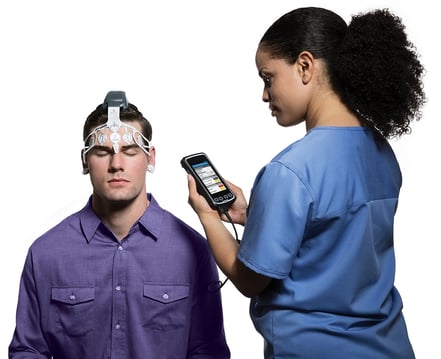The COVID-19 pandemic stretched emergency departments (EDs) beyond their capacity and highlighted the resource needs of the system. Before the pandemic, EDs were already overburdened with increasing visits. More than 60% of all hospitals’ admissions come through the ED and 90% routinely report overcrowding/boarding.
One patient population contributing to the increase is the head injured patient. With greater public awareness around the impact and consequences of head injuries, more patients are showing up to the ED. More than 7 million head injuries occur annually, with almost 5 million presenting to the ED. Most of these patients, about 80%, will be sent for a CT scan to assess for a brain bleed.
This population is often mild and may be termed “worried well.” As their condition is not life-threatening, these patients are typically placed at the back of the line for assessment and treatment. This pathway can lead to an average patient length of stay of 6 or more hours.

What does this have to do with the role of emergency medicine technicians? Technicians support nurses and physicians by monitoring vital signs, taking patient samples, dressing wounds, and additional administrative support. With the current pathway for head injured patients, the technician's role will likely not impact process efficiency.
Incorporating a point of care decision support tool for mild head injured patients offers a new pathway for patients and is a tool that can be operated by technicians. This technology can help reduce patient length of stay and enlisting technicians can help reduce the burden on the nursing team.
BrainScope is an objective decision support tool that indicates the likelihood of being negative for brain bleed on a CT and identifies those that need further evaluation. Within 20 minutes, the patient and provider have actionable results to either discharge, evaluate further, and/or provide informed referrals for follow-up care.

EDs can incorporate BrainScope into their triage process, patient assessment, or wherever it makes sense in their processes and protocols. The device is intuitive and can be operated with minimal to no training. It uses a handheld device that incorporates on-screen support to guide every step of the way connected to a disposable, single-patient headset. The easy-to-read results screen does not require specialist physician interpretation.
While the average assessment time is within 20 minutes, hospital experience has shown an average of 11 minutes of total test time when technicians conduct the assessment. Incorporating technicians into this workflow allows nurses to tend to higher acuity patients. Technicians can assist nurses and physicians with:
- Capturing patient demographics and injury information*
- Follow along with the on-screen prompts and input the information into the device
- The device requires confirmation of inputs before proceeding
- Prepping the patient and applying the headset
- A simple 2-step prep process with guided electrode application
- The device notifies if the application is correct or where additional prep is required
- On-screen videos detail exactly how to prep the patient and apply the electrodes
- Coaching the patient through the assessment to ensure timely data collection
* Some hospitals’ policies may not permit technicians from capturing patient information. Time savings can still be realized by incorporating technicians into the patient prep and coaching.
BrainScope can give EDs a new pathway for their head injured patients. Clinical experience has demonstrated a 60% reduction in unnecessary head CTs and a 40% improvement in patient length of stay.


